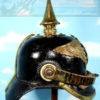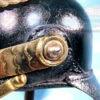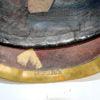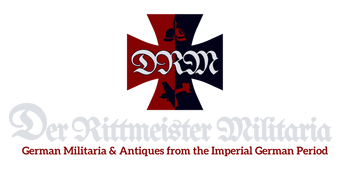Prussian 2. Garde-Regiment zu Fuß M1871 NCO Pickelhaube, Berlin Garrison
- Regular price
- $4,295.00
- Sale price
- $4,295.00
- Regular price
- $4,695.00
SKU: 04-541
This helmet represents a rare surviving example of the Model 1871 Pickelhaube worn by an enlisted man or non-commissioned officer (NCO) of the 2. Garde-Regiment zu Fuß, the senior infantry formation of the Prussian Gardekorps. The regiment, founded in 1813 during the Wars of Liberation, was permanently garrisoned in Berlin, serving under the personal authority of the King of Prussia and later the Kaiser. Together with the 1. Garde-Regiment zu Fuß and the Garde-Füsilier-Regiment, it formed the nucleus of the Imperial Guard Infantry and remained one of the most elite line units in the German Empire.
Physical Description
The helmet body is of thick black-lacquered leather, taller and more upright in profile than the later 1891/1897 models. Both the front and rear visors are extended and steeply flared—distinctive features of the M1871 pattern, transitional between the early M1842 tall Pickelhaube and the shortened models of the 1890s. The leather remains solid and retains its shape, with only minor shrinkage at the visor edges typical of helmets of this age.
All exterior fittings are bright fire-gilt brass except for the silvered Garde Star mounted to the eagle’s breast. The frontplate (Wappen) displays the Prussian Guard Eagle, crowned and spreading its wings across the helmet’s front, bearing sword and scepter in its talons and surmounted by the banner “MIT GOTT FÜR KOENIG UND VATERLAND”. At the center rests the eight-pointed silver Garde Star, bearing the enameled medallion of the Order of the Black Eagle encircled by the motto “SUUM CUIQUE” (“To Each His Own”). This device, unchanged from the Guard’s adoption of the pattern in 1842, symbolized direct service to the sovereign.
The helmet’s spike is tall and conical, secured by four bolts through the cruciform base and fully detachable by unscrewing—typical of officer and NCO-quality manufacture prior to 1891. Both front and rear visor trims are gilt brass with tight, clean edges. The flat chinscales, also gilt, are mounted to rosettes by leather tabs. The single state kokarde, the black-white-black colours of Prussia, is affixed to the right side; this is correct for helmets produced before the 1897 order that introduced the second national (Reich) cockade and reversed the side positions.
The interior retains its complete leather enlisted liner with all tongues intact, though the drawstring is absent. Stitching is sound and unaltered. The rear visor trim is secured by its original screw and washer (nut absent). Inside the front visor’s brass trim appears the stamped maker’s mark “G. Scholz Nachf.”, a known Berlin contractor supplying Guard units in the 1870s–1880s. All hardware beneath the plate remains original, and no extra holes are visible, confirming that the Wappen has not been replaced.
Historical Context
The 2. Garde-Regiment zu Fuß stood at the pinnacle of Prussian military prestige. Created during the struggle against Napoleonic occupation, it fought in every major Prussian campaign of the 19th century—Königgrätz (1866), Sedan (1870)—and after 1871 became a permanent symbol of the Kaiser’s household troops. Together with the 1. and 3. Garde Regiments, it formed part of the 1. Garde-Infanterie-Brigade, 1. Garde-Division, within the Gardekorps headquartered in Berlin and Potsdam.
Within this system, Guard units wore distinctive insignia and enjoyed privileges in pay, uniform, and ceremonial precedence. Their helmets bore the silver Garde Star rather than the plain eagle shield of the line infantry, visually declaring their elite status. Prior to the 1897 regulation changes, each Guard soldier wore only the Prussian kokarde, underscoring the regiment’s direct allegiance to the King rather than the later unified empire.
The M1871 Pickelhaube itself marks an important stage in Prussian uniform evolution. Introduced after the Franco-Prussian War, it retained the earlier tall profile but incorporated improved fittings and a detachable spike. This pattern remained in production until replaced by the M1895/1897 model, making surviving examples with full Garde insignia exceedingly scarce.
Collector Evaluation
Condition is very fine, showing honest age and complete originality. The lacquered leather body is firm and retains 95 percent of its gloss; the gilt fittings display mild, attractive toning; and the silver Garde Star remains bright with excellent relief and detail. All components are period and untouched. The helmet’s maker mark, single kokarde configuration, and tall 1871 profile confirm early manufacture.
Early Guard enlisted or NCO helmets seldom survive intact due to heavy ceremonial use and later modification to 1897 specifications. This specimen, unaltered and clearly marked to a Berlin supplier, represents the 2. Garde-Regiment zu Fuß at the height of its prestige and provides an important reference for collectors studying the evolution of Guard equipment.

























